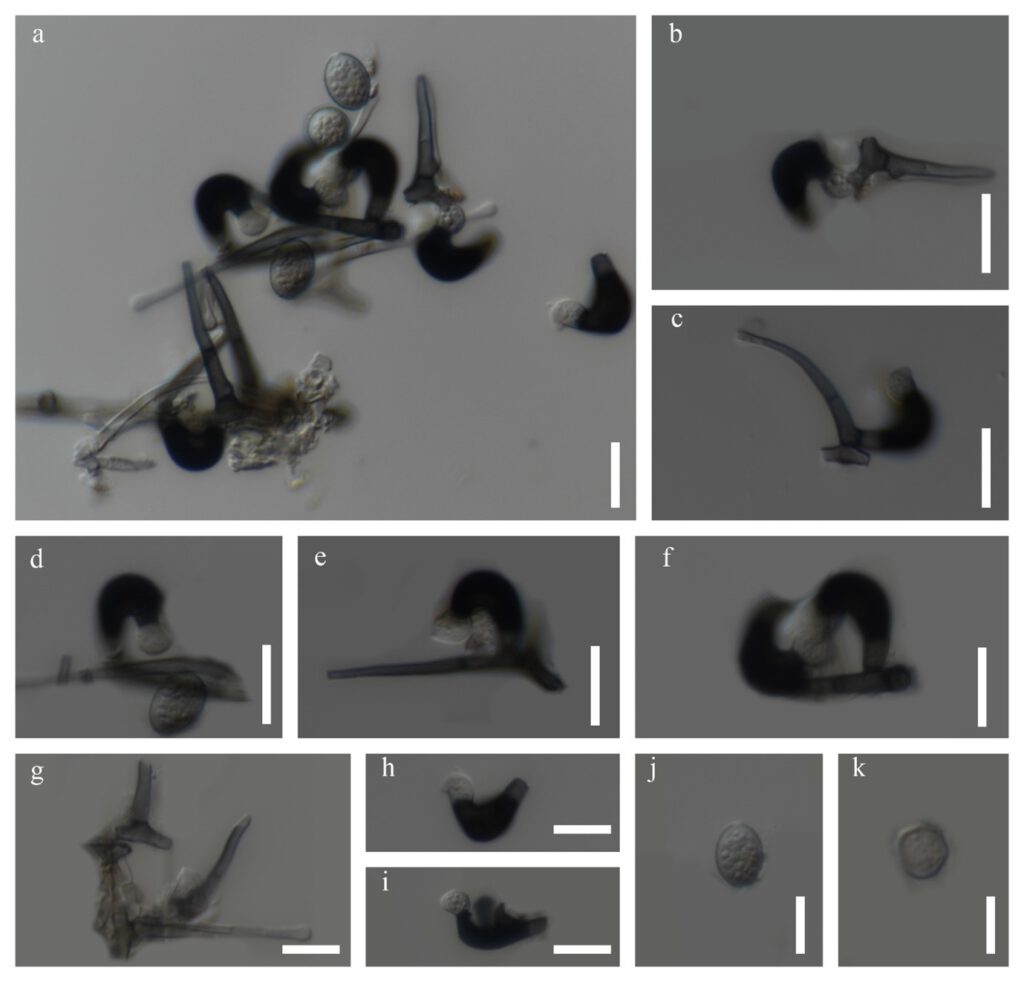Zygosporium dracaenae Chaiwan & K.D. Hyde, sp. nov.
Index Fungorum number: IF 371607; MycoBank number: MB 371607; Facesoffungi number: FoF 12774 *, Fig. **.
Etymology – The specific epithet reflects the host Dracaena sp.
Saprobic on dead leaves of Dracaena sp. Sexual morph: Undetermined. Asexual morph: Hyphomycetous, Mycelium 2.5–4 μm wide, plerumque superficial, partim in substrate superficial, cylindrical, pallidae brunneae, laevia, septations, ramosa. Setae and setiform conidiophores 60–100 × 4–5.5 μm towards the base, 1–1.5 μm wide at the apical cell subhyaline, smooth, narrowly clavate, septa, erect, straight, curved or flexuous, tapered from the base, narrowing towards the apex, smooth, 3-4-septate, brown except for the pale apical cell, thickened walls and obtuse, upper section of the setiform conidiophore sterile, first cell giving rise to a single vesicular conidiophore, basal cell concolorous with the lower parts of the setae, branching in two directions becoming part of the mycelium and connecting the conidiophores. Vesicular conidiophores 5–8 × 4.5–5 μm, arising on the side of the first cell of the setiform conidiophore, are comprised of three cell types; stalk cell cylindrical, brown, thick-walled, smooth; vesicular cell dark brown to black, thick-walled, smooth, swollen, upwardly curved, inner curvature paler than the rest of the cell, 15–16 × 8–9 μm. Conidiogenous cells 4–6 × 1–3 μm (x̅ = 5 × 2 μm, n = 20), arise directly from the vesicular cell, monoblastic, discrete, determinate, swollen, ampulliform, upwardly curved, smooth, pale brown, apex obtuse. Conidia 3.5–7.5 μm, solitary, dry, initially globose, later become spherical to broadly ellipsoid, aseptate, subhyaline to brown, thick-walled.
Material examined – Thailand, Kanchanaburi Province, on dead leaves of Dracaena sp., 24 October 2018, Napalai Chaiwan, KAN12 (MFLU 22-0124, holotype).
GenBank accession numbers – ITS:OM914646.
Notes – Based on the multigene analyses, our isolate clustered in a sister clade with Zygosporium echinosporum, Z. masonii, Z. mycophilum, and Z. oscheoides. The Blastn search results showed that the ITS sequences of our isolate are 89.14% identical to Z. oscheoides (MFLUCC 14-0402) which was found on Ptychosperma macarthurii (Arecaceae). Our collection shares similar morphological characteristics with Z. pandanicola. Zygosporium pandanicola is unique in having a vesicular cell produced from the side of the setiform conidiophores; the subhyaline of the setiform conidiophores is smooth, acute or narrowly clavate, spherical conidia, globose to ellipsoid, hyaline to pale brown, smooth to minutely verruculose (Whitton et al. 2003). Based on the known distribution and host of Z. pandanicola from Whitton et al. (2003), our isolate is the first-time reported Z. pandanicola as a saprobe from Dracaena sp. in Thailand and our isolate is assigned here as the first time to provide sequence data for Z. pandanicola.

Figure 1 – Zygosporium dracaenae (MFLU 22-0124, Holotype). a, b, g Conidiophores with vesicles. c–f, h–i Vesicles and conidiogenous cells. j–k conidia. Scale bars: a–k = 10 µm.
